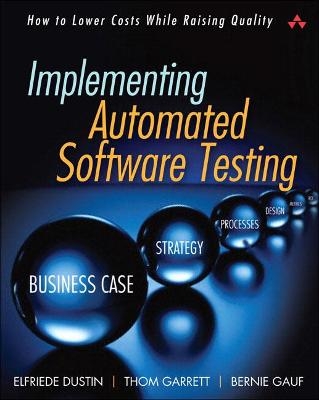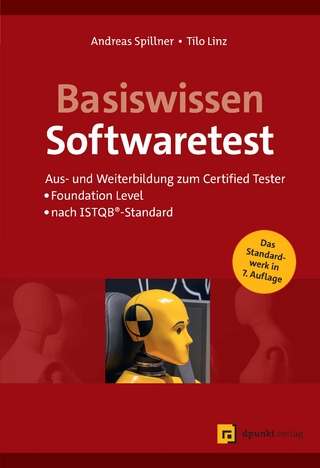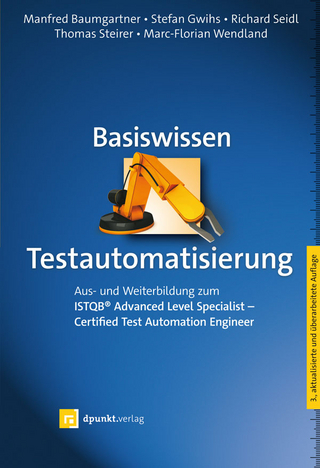
Implementing Automated Software Testing
Addison-Wesley Educational Publishers Inc (Verlag)
978-0-321-58051-1 (ISBN)
- Keine Verlagsinformationen verfügbar
- Artikel merken
—Jeff Offutt, Professor of Software Engineering, George Mason University
“This new book naturally expands upon its predecessor, Automated Software Testing, and is the perfect reference for software practitioners applying automated software testing to their development efforts. Mandatory reading for software testing professionals!”
—Jeff Rashka, PMP, Coauthor of Automated Software Testing and Quality Web Systems
Testing accounts for an increasingly large percentage of the time and cost of new software development. Using automated software testing (AST), developers and software testers can optimize the software testing lifecycle and thus reduce cost. As technologies and development grow increasingly complex, AST becomes even more indispensable. This book builds on some of the proven practices and the automated testing lifecycle methodology (ATLM) described in Automated Software Testing and provides a renewed practical, start-to-finish guide to implementing AST successfully.
In Implementing Automated Software Testing, three leading experts explain AST in detail, systematically reviewing its components, capabilities, and limitations. Drawing on their experience deploying AST in both defense and commercial industry, they walk you through the entire implementation process—identifying best practices, crucial success factors, and key pitfalls along with solutions for avoiding them. You will learn how to:
Make a realistic business case for AST, and use it to drive your initiative
Clarify your testing requirements and develop an automation strategy that reflects them
Build efficient test environments and choose the right automation tools and techniques for your environment
Use proven metrics to continuously track your progress and adjust accordingly
Whether you’re a test professional, QA specialist, project manager, or developer, this book can help you bring unprecedented efficiency to testing—and then use AST to improve your entire development lifecycle.
Elfriede Dustin, Thom Garrett, and Bernie Gauf work together at Innovative Defense Technologies ( www.idtus.com), which specializes in the design, development, and implementation of automated software testing solutions. Elfriede Dustin has authored multiple software testing books and articles based on her many years of actual hands-on automated software testing experience. Elfriede leads IDT’s efforts in automated software testing research programs. Thom Garrett has experience in planning, testing, and deployment of complex systems for DoD and commercial applications for companies such as Public Broadcasting Service (PBS), Digital System Resources (DSR), Inc., and America Online (AOL). Thom received a master’s degree from the University of San Francisco. Bernie Gauf is the president of IDT. Bernie has been invited to participate in numerous DoD panels associated with the use of new technology, testing conferences, and as a guest speaker to share his insights on automated software testing.
Foreword by Admiral Edmund P. Giambastiani, Jr. xv
Foreword by Dr. William Nylin, Jr. xvii
Preface xix
Acknowledgments xxiii
About the Authors xxv
Part I: What Is Automated Software Testing and Why Should We Automate? 1
Chapter 1: What Is Effective Automated Software Testing (AST)? 3
1.1 Automated Software Testing Definition 4
1.2 Automated Software Testing Recipes 5
1.3 Advances in AST Technologies 8
1.4 Automating Various Software Testing Types 11
1.5 Providing AST-Based Production Support 16
1.6 Automating Standards Assessments 18
Summary 20
Notes 21
Chapter 2: Why Automate? 23
2.1 The Challenges of Testing Software Today 24
2.2 Reducing the Time and Cost of Software Testing 26
2.3 Impacting Software Quality 38
2.4 Improvements to Your Software Test Program 42
Summary 49
Notes 50
Chapter 3: The Business Case 51
3.1 Definition of the Business Case 51
3.2 Identifying the Business Needs 53
3.3 Justifying Automation in Terms of Cost and Benefits 55
3.4 Risks 65
3.5 Other Considerations 67
Summary 68
Notes 68
Chapter 4: Why Automated Software Testing Fails and Pitfalls to Avoid 69
4.1 R&D Does Not Generally Focus on Automated or Manual Testing Efforts 71
4.2 AST Myths and Realities 74
4.3 Lack of Software Development Considerations for AST 83
4.4 The Forest for the Trees—Not Knowing Which Tool to Pick 91
4.5 Lack of Automation Standards across Tool Vendors 94
4.6 Lack of Business Case 97
Summary 97
Notes 97
Part II: How to Automate: Top Six Keys for Automation Payoff 99
Chapter 5: Key 1: Know Your Requirements 101
5.1 Understand the AST Support Requirements 102
5.2 Additional Information in Support of AST Requirements 114
5.3 When Information Is Not Available 116
5.4 Start Implementing Your Requirements Traceability Matrix (RTM) 124
Summary 128
Notes 128
Chapter 6: Key 2: Develop the Automated Test Strategy 129
6.1 The AST Strategy Document 131
6.2 Scope and Automated Test Objectives 132
6.3 Identify the Approach 139
6.4 Automated Software Test Framework (ASTF) 146
6.5 AST Environment/Configuration 150
6.6 Automating the RTM 159
6.7 Automated Defect Tracking 164
Summary 164
Notes 165
Chapter 7: Key 3: Test the Automated Software Test Framework (ASTF) 167
7.1 Verify That the ASTF Meets Specified Requirements and That Features Behave As Expected 169
7.2 Peer-Review All ASTF-Related Artifacts, Including Design, Development, and Test Cases 170
7.3 Verify Requirements and Coverage 182
7.4 Hold a Customer Review 183
Summary 184
Notes 184
Chapter 8: Key 4: Continuously Track Progress—and Adjust Accordingly 187
8.1 AST Program Tracking and Defect Prevention 188
8.2 AST Metrics 192
8.3 Root Cause Analysis 205
Summary 206
Notes 207
Chapter 9: Key 5: Implement AST Processes 209
9.1 AST Phases and Milestones 211
9.2 AST Phase 1: Requirements Gathering—Analyze Automated Testing Needs 212
9.3 AST Phase 2: Test Case Design and Development 215
9.4 AST Phase 3: Automated Software Testing Framework (ASTF) and Test Script Development 216
9.5 AST Phase 4: Automated Test Execution and Results Reporting 217
9.6 AST Phase 5: Program Review and Assessment 218
9.7 Virtual Quality Gates 219
9.8 Process Measurement 220
Summary 221
Notes 222
Chapter 10: Key 6: Put the Right People on the Project—Know the Skill Sets Required 223
10.1 Program Management 232
10.2 Systems Engineering 236
10.3 Software Development 239
10.4 Configuration Management 242
10.5 Quality Assurance 244
10.6 Subject Matter Experts (SMEs) 246
Summary 247
Notes 248
Appendices 249
Appendix A: Process Checklist 251
A.1 AST Phase 1: Requirements Gathering—Analyze Automated Testing Needs 252
A.2 AST Phase 2: Test Case Design and Development 253
A.3 AST Phase 3: Automated Software Testing Framework (ASTF) and Test Script Development 254
A.4 AST Phase 4: Automated Test Execution and Results Reporting 255
A.5 AST Phase 5: Program Review and Assessment 256
Appendix B: AST Applied to Various Testing Types 257
B.1 Security Testing 257
B.2 Soak Testing 261
B.3 Concurrency Testing 263
B.4 Performance Testing 265
B.5 Code Coverage Testing 269
B.6 Unit Testing 271
Notes 274
Appendix C: The Right Tool for the Job 275
C.1 Requirements Management (RM) 276
C.2 Unit Testing Frameworks—Example Evaluation 281
C.3 Configuration Management—Example Evaluation 284
C.4 Defect Tracking—Example Evaluation 292
C.5 Security Testing 299
C.6 Automated Software Testing Framework (ASTF)—Example Evaluation 306
C.7 Other STL Support Tools 316
Notes 319
Appendix D: Case Study: An Automated Software Testing Framework (ASTF) Example 321
D.1 Key Design Features 323
D.2 Test Manager 325
D.3 More on Automated Test Case and Test Code Generation 326
D.4 Results Reporting 328
D.5 Automated Defect Reporting 328
Notes 329
Contributing Authors 331
Index 333
| Erscheint lt. Verlag | 2.4.2009 |
|---|---|
| Verlagsort | New Jersey |
| Sprache | englisch |
| Maße | 189 x 234 mm |
| Gewicht | 726 g |
| Themenwelt | Informatik ► Software Entwicklung ► Qualität / Testen |
| ISBN-10 | 0-321-58051-6 / 0321580516 |
| ISBN-13 | 978-0-321-58051-1 / 9780321580511 |
| Zustand | Neuware |
| Haben Sie eine Frage zum Produkt? |
aus dem Bereich


